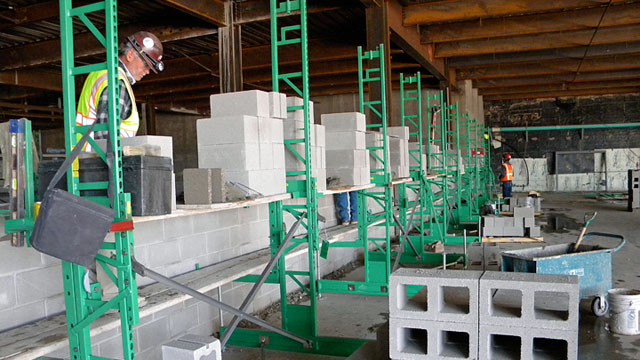May 25, 2011 12:05 PM CDT
“That’s why we invented Workhorse,” says Justin Breithaupt, owner of Non-Stop Scaffolding. “Short walls are nothing but stop-and-go work. Workhorse eliminates running walls scaffold-high and then moving, and all the stopping to hop planks. It’s amazing how fast short walls go up when the masons never stop.”
The key to the Workhorse system is something that’s never been done before: putting the scaffold in place before the wall is started. When the wall reaches scaffold-high, the masons continue working instead of moving.
According to Breithaupt, “The bricklayers never lose their momentum. You gain a course instead of moving your men or sliding the scaffold in place. And, from then on, the wall is always waist-high. With frames, you might stop working four times on a 14-foot-high wall, but with Workhorse you don’t stop even once.”
Working this way makes the job much simpler, since there is a lot less for the laborers to do, and they stay with the masons all the time. When it’s time to move the scaffold, it can be rolled to the next wall on casters, or moved easily by hand (each side weighs only 130 pounds).
To learn more, visit www.nonstopscaffolding.com/wh.
Workhorse Makes Short Work of Short Walls
Product watch
By Masonry

Workhorse base unit puts the mason’s feet at eight feet, six inches above the floor.
The majority of mason contractors who fall in love with adjustable scaffolding and mast climbers want to use it everywhere they possibly can, even at their short walls and inside walls, like hallways and partitions. A lightweight adjustable scaffold appears to be exactly what they want.“That’s why we invented Workhorse,” says Justin Breithaupt, owner of Non-Stop Scaffolding. “Short walls are nothing but stop-and-go work. Workhorse eliminates running walls scaffold-high and then moving, and all the stopping to hop planks. It’s amazing how fast short walls go up when the masons never stop.”
The key to the Workhorse system is something that’s never been done before: putting the scaffold in place before the wall is started. When the wall reaches scaffold-high, the masons continue working instead of moving.
According to Breithaupt, “The bricklayers never lose their momentum. You gain a course instead of moving your men or sliding the scaffold in place. And, from then on, the wall is always waist-high. With frames, you might stop working four times on a 14-foot-high wall, but with Workhorse you don’t stop even once.”
Working this way makes the job much simpler, since there is a lot less for the laborers to do, and they stay with the masons all the time. When it’s time to move the scaffold, it can be rolled to the next wall on casters, or moved easily by hand (each side weighs only 130 pounds).
To learn more, visit www.nonstopscaffolding.com/wh.
About the Author
Masonry, the official publication of the Mason Contractors Association of America, covers every aspect of the mason contractor profession - equipment and techniques, building codes and standards, business planning, promoting your business, legal issues and more. Read or subscribe to Masonry magazine at www.masonrymagazine.com.


















